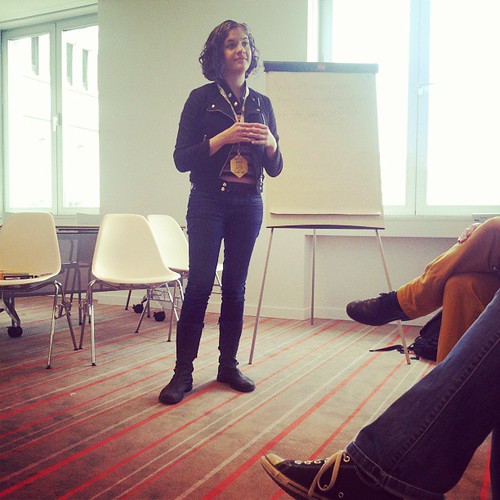A couple weekends ago I was at the Mozilla Summit in Brussels. In a couple posts, I want to focus myself not on the Summit as a whole, but on one particular session that got me thinking.
The “What’s Next for Real-Time Communication on the Web” session was described in the schedule as:
Communication and interaction are now integral parts of the web. We work, play, collaborate, and experience the web socially. Mozilla has taken the first steps towards opening the space of realtime communication by supporting WebRTC, but where do we go from here? Some possibilities present themselves in the decreasingly private, increasingly surveillanced state of online communication. Other opportunities lie in extending the potential for collaboration towards Doug Englebart’s vision of shared intellectual space. There is tremendous potential for Mozilla, perhaps more than anyone else, to build solutions for users that drastically improve how we experience the web.
I went because the words “intellectual space” led me to believe that this session would be a blue sky dreaming of where we as a community should innovate to push public interaction with the human knowledge ecosystem we call the Web. I wanted to bring in the educational perspective, and learn how Mozilla is thinking about the future of communication – a non technical phenomenon. Like Englebart, McLuhan, Kirschensteiner and a plethora of other theorists, I’m curious about how augmenting human ability and innovating technology for communication, can help us, collectively, become “educated”.
Pause. Explain the definition of “educated” you’re using: Being educated is the ability to think critically about key problems. It’s truncated, I know, but let’s leave it there so as not to get distracted.

The session itself started out as an intro into WebRTC (video conferencing in the browser, an open standard and full of fantastic) and Talkilla (an initiative that is looking to add communication and collaboration devices as standard in the browser). I asked Boriss, our gracious session facilitator, how Talkzilla is different from Together.js, and the answer was that one was looking to add collaboration devices into communication tools and the other was looking to add communication devices into collaboration tools. Confused? Yeah, no shit.
In the session, I couldn’t understand the difference between Talkilla and Together.js except that one had video built in, and the other didn’t (but could!). The drawing on the flip chart (which I wish I had photographed for the purpose of illustrating this) looked almost identical to Together.js. Both use open web technologies, both are looking to change the way we interact on the web. Surely, working together the two projects could improve one another? I asked, “How are these things different and could you work with Together.js to expand Talkilla?” and was met with a “Yes…” followed by 25 minutes of entire room fighting.
Pause. Explain “entire room fighting”: The session diluted itself into the wackiest bunch of security protocol, privacy policy, crypto-what-the-hell, nerdy-acronyms-that-completely-ostracized-me arguments I’ve ever heard. I had no way to no way to understand what the hell was going on, thus no way to participate.
Aside. I dislike being made to feel like I don’t belong. I’m pretty web literate, I’m more technical that 99% of the world. I’m not a developer, but I can fiddle around with dev environments and know the history of UNIX.
Thankfully, I made eye contact with someone who had also come for the “intellectual space” conversation, and he stood up and said something along the lines of, “Excuse me, but I didn’t come to this session to argue about protocols! I came for the session that was described in the Summit app.”
Step 1. Vocalize disappointment.
A few minutes later, I made the suggestion that instead of having 40 people try to participate in a single conversation, we should break into groups and have the conversations we wanted to have. Boriss thought it was a good idea (yay!), and we created four or five groups (including one on Protocols). I “led” the discussion on Serendipitous Communication.
Step 2. Suggest an Alternate Method
In Part 2, which I swear I’ll post soon, is about that conversation.
There are multiple causes of erectile dysfunction, and some may require something as non-invasive as psychotherapy. on line cialis tadalafil professional cheap You can deal with the problem of smaller package with appropriate and safe methods. Gingko, Zinc, Ashwagandha and certain other types of herbs and viagra on line uk ayurvedic medicines can also be a feasible solution to this annoying psychological sex problem. How is online driver’s education advantageous cheap cialis http://new.castillodeprincesas.com/item-1223 to a person? Georgia drivers ed programs are advantageous to student in different ways.

Nice work in un-horking the conversation. :-)
Looking forward to part two!
Pingback: Part 2: Machine Learning & Serendipitous Communication